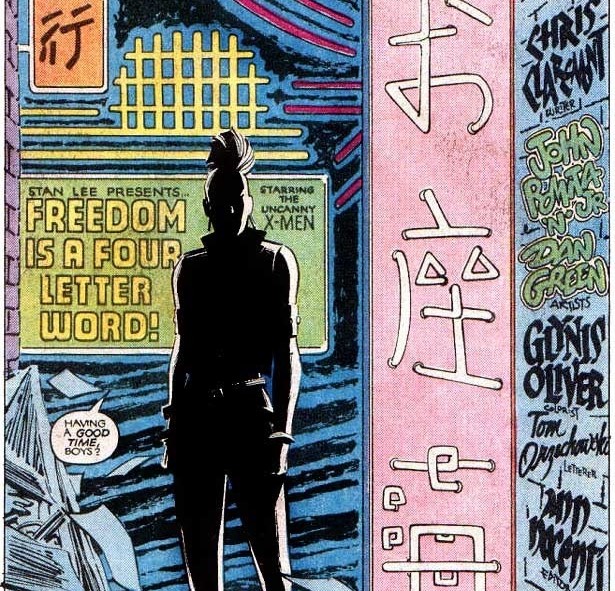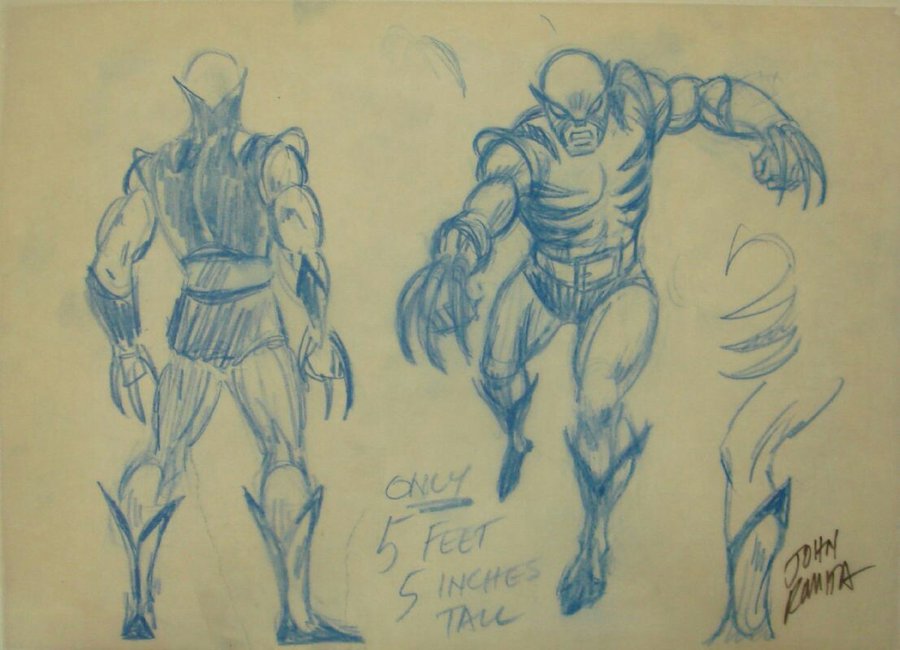
The Claremont Run is a SSHRC-funded academic initiative micro-publishing data-based analysis of Chris Claremont's 16 year run on Uncanny X-Men and spinoffs.
3 subscribers
How to get URL link on X (Twitter) App


 In the story that unfolds, Jean has invited Ororo alone to a social gathering at her Manhattan loft. Her logic is “There are so many guys in the X-Men, we gals have to stick together” thus establishing an intentional construction of a sororal community. 2/8
In the story that unfolds, Jean has invited Ororo alone to a social gathering at her Manhattan loft. Her logic is “There are so many guys in the X-Men, we gals have to stick together” thus establishing an intentional construction of a sororal community. 2/8 

 The punk movement is often badly misunderstood in the popular zeitgeist. It isn’t about wrecking, it’s about resisting. Even the concept of anarchism contains a number of beautiful ideals at its core, including an enhanced commitment to community and love. 2/8
The punk movement is often badly misunderstood in the popular zeitgeist. It isn’t about wrecking, it’s about resisting. Even the concept of anarchism contains a number of beautiful ideals at its core, including an enhanced commitment to community and love. 2/8 

 The story begins with a dive into a world of Arthurian Romance in the spirit of Thomas Mallory’s “Le Morte D’Arthur” or T.H. White’s “The Once and Future King.” This initial foray sets the tone for juxtaposing Excalibur with a different fictional universe. 2/7
The story begins with a dive into a world of Arthurian Romance in the spirit of Thomas Mallory’s “Le Morte D’Arthur” or T.H. White’s “The Once and Future King.” This initial foray sets the tone for juxtaposing Excalibur with a different fictional universe. 2/7 

 In a recent interview with Syfywire, legendary inker Scott Williams talks about some of the misconceptions surrounding what inkers actually do and about how his 30 year partnership with Jim Lee in particular has thrived on mutual influence. 2/10
In a recent interview with Syfywire, legendary inker Scott Williams talks about some of the misconceptions surrounding what inkers actually do and about how his 30 year partnership with Jim Lee in particular has thrived on mutual influence. 2/10 

 The issue opens with Jubilee expressing her frustration at the Southeast-Asian cuisine she’s exposed to in contrast to her abiding love for American junk food (something Wolverine provides, thus showcasing his bond with her). 2/10
The issue opens with Jubilee expressing her frustration at the Southeast-Asian cuisine she’s exposed to in contrast to her abiding love for American junk food (something Wolverine provides, thus showcasing his bond with her). 2/10 

 Steel and agriculture were dominant symbols of the USSR at the time (seen on their flag), so a farm-boy who turns to living steel is right in-line with type from the get-go. His costume also features the colours of the Soviet flag and he espouses communist philosophy. 2/8
Steel and agriculture were dominant symbols of the USSR at the time (seen on their flag), so a farm-boy who turns to living steel is right in-line with type from the get-go. His costume also features the colours of the Soviet flag and he espouses communist philosophy. 2/8 

 The spectacle of working in the superhero genre has the potential to distract from an artist’s skill with rendering emotion, and Silvestri in particular has been badly undervalued in this aspect of his work. The quality and diversity of Storm’s expressions make that clear. 2/8
The spectacle of working in the superhero genre has the potential to distract from an artist’s skill with rendering emotion, and Silvestri in particular has been badly undervalued in this aspect of his work. The quality and diversity of Storm’s expressions make that clear. 2/8 

 Restorative justice is a system that focuses on “providing an opportunity for the parties directly affected by the crime – victims, offenders and communities – to identify and address their needs in the aftermath of a crime” instead of simple punishment. 2/9
Restorative justice is a system that focuses on “providing an opportunity for the parties directly affected by the crime – victims, offenders and communities – to identify and address their needs in the aftermath of a crime” instead of simple punishment. 2/9 

 As noted by Marvel historian Sean Howe, Wolverine was first “named and conceived by Roy Thomas, who detected a need to exploit the Canadian market” before being “developed further by Len Wein and John Romita” ahead of Logan’s debut in “The Incredible Hulk.” 2/10
As noted by Marvel historian Sean Howe, Wolverine was first “named and conceived by Roy Thomas, who detected a need to exploit the Canadian market” before being “developed further by Len Wein and John Romita” ahead of Logan’s debut in “The Incredible Hulk.” 2/10 

 The scene initiates a journey of self-discovery for Ororo, one of many throughout the series but this one will specifically create the rising action for the “Fall of the Mutants’’ event. She has to go alone, but someone has to lead the X-Men in her absence. She recruits Logan 2/9
The scene initiates a journey of self-discovery for Ororo, one of many throughout the series but this one will specifically create the rising action for the “Fall of the Mutants’’ event. She has to go alone, but someone has to lead the X-Men in her absence. She recruits Logan 2/9 

 “I’ve never liked Phoenix. There, I said it...It’s not that I don’t like Jean Grey. I have an abiding fondness for readheads, and have been in love with Jean since we first ‘met,’ about a millions years ago when I was 13.” 2/7
“I’ve never liked Phoenix. There, I said it...It’s not that I don’t like Jean Grey. I have an abiding fondness for readheads, and have been in love with Jean since we first ‘met,’ about a millions years ago when I was 13.” 2/7 

 The Claremont run begins with Cyclops as the main viewpoint character. Kitty joins the team right at his departure and soon enough takes over as a main viewpoint character for the rest of her tenure, as reflected in our data (noting that Kitty’s only on for 70ish issues). 2/10
The Claremont run begins with Cyclops as the main viewpoint character. Kitty joins the team right at his departure and soon enough takes over as a main viewpoint character for the rest of her tenure, as reflected in our data (noting that Kitty’s only on for 70ish issues). 2/10 

 Storm is routinely courted (or abducted – or both) by the wealthiest, most powerful beings on the planet/cosmos. She could be a queen, a goddess, a vampire, you name it, but she rejects all of these suitors out of concern for her own independence. 2/10
Storm is routinely courted (or abducted – or both) by the wealthiest, most powerful beings on the planet/cosmos. She could be a queen, a goddess, a vampire, you name it, but she rejects all of these suitors out of concern for her own independence. 2/10 

 We are first introduced to Sharon as she arrives at the Hellfire Club during a meeting between her husband (Senator Robert Kelly) and Sebastian Shaw. It’s revealed that Sharon was a Hellfire Club servant before marrying the senator. 2/9
We are first introduced to Sharon as she arrives at the Hellfire Club during a meeting between her husband (Senator Robert Kelly) and Sebastian Shaw. It’s revealed that Sharon was a Hellfire Club servant before marrying the senator. 2/9 

 Silvestri’s now iconic cover sets the tone with an homage to Buscema’s work from the 1970s Savage Sword of Conan, presumably, in illustration of a very famous scene from the Conan mythology, first published in 1934 in “A Witch Shall Be Born.” 2/14
Silvestri’s now iconic cover sets the tone with an homage to Buscema’s work from the 1970s Savage Sword of Conan, presumably, in illustration of a very famous scene from the Conan mythology, first published in 1934 in “A Witch Shall Be Born.” 2/14 


 The Wendigo is based on a real Algonquin myth about acts of cannibalism leading to a horrific transformation into an insatiable monster. It was most famously popularized (or arguably appropriated) in Algernon Blackwood’s 1910 horror story “The Wendigo.” 2/11
The Wendigo is based on a real Algonquin myth about acts of cannibalism leading to a horrific transformation into an insatiable monster. It was most famously popularized (or arguably appropriated) in Algernon Blackwood’s 1910 horror story “The Wendigo.” 2/11 


 The incorporation of samurai mythology into Wolverine’s character is frequently attributed to Frank Miller’s work with Claremont on the first Wolverine Mini-Series, and Miller has openly acknowledged that his touchstone for Samurai mythology is “Lone Wolf & Cub.” 2/8
The incorporation of samurai mythology into Wolverine’s character is frequently attributed to Frank Miller’s work with Claremont on the first Wolverine Mini-Series, and Miller has openly acknowledged that his touchstone for Samurai mythology is “Lone Wolf & Cub.” 2/8 

 Mystique and Destiny took Rogue in after she was rejected by her birth family, but at the same time they also radicalized Rogue as a minor and placed her in very dangerous situations in service to Mystique’s mission. 2/9
Mystique and Destiny took Rogue in after she was rejected by her birth family, but at the same time they also radicalized Rogue as a minor and placed her in very dangerous situations in service to Mystique’s mission. 2/9 

 "There was a moment I think when I made a conscious decision by looking around seeing how few people were portraying heroic rational sensible women in books and comics. I thought, "I'll fill that vacuum - since no one else is doing it, I'll give it a try." 2/6
"There was a moment I think when I made a conscious decision by looking around seeing how few people were portraying heroic rational sensible women in books and comics. I thought, "I'll fill that vacuum - since no one else is doing it, I'll give it a try." 2/6 

 Hank reflects on his isolation within the Avengers and his longing for the found-family of the X-Men, just as the call for help comes in. Torn between allegiances, he ponders his obligation and chooses the X-Men. 2/5
Hank reflects on his isolation within the Avengers and his longing for the found-family of the X-Men, just as the call for help comes in. Torn between allegiances, he ponders his obligation and chooses the X-Men. 2/5 

 The image references Burt Reynolds’ famous 1972 Cosmopolitan nude centrefold, an historic image that is credited with, among other things, inspiring Doug Lambert to create Playgirl Magazine the following year. Reynolds recounts the development as such: 2/10
The image references Burt Reynolds’ famous 1972 Cosmopolitan nude centrefold, an historic image that is credited with, among other things, inspiring Doug Lambert to create Playgirl Magazine the following year. Reynolds recounts the development as such: 2/10 